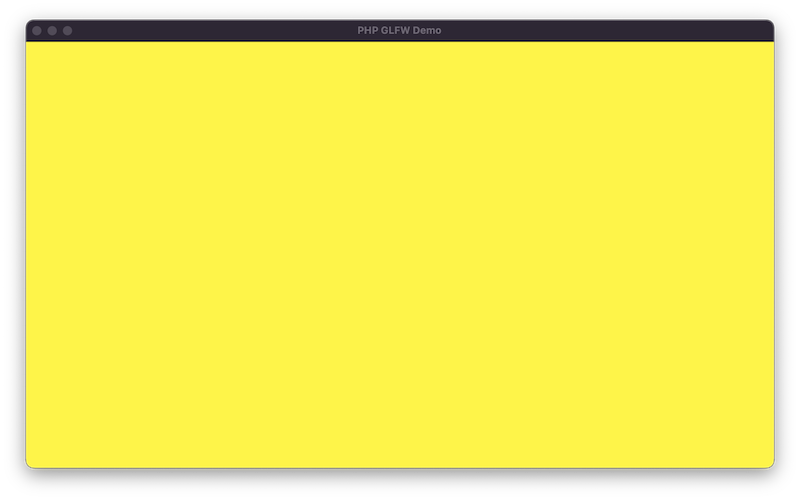Opening a Window¶
Before we get to drawing anything, we need to open a window and create a context in which we can actually draw in. This requires some boilerplate code which we discuss in this guide.
Opening a window is a operating system specific task, so we usally would have to write a different program for each platform. However, as the name of this extension suggests PHP-GLFW is built on top of the GLFW library, which provides a cross-platform API for opening a window, creating a context and receiving input events for us. Having plattform specific code in PHP just doesnt feel right, so we use GLFW to do the dirty work for us.
PHP-GLFW already installed?
Follow the installation guide if you haven't installed the extension yet!

Not a very exciting screenshot, I know. But first things first, the fun stuff is coming later.
Full Source
This getting started tutorial is based on the examples provided with PHP-GLFW.
You can check out the complete source code here: 01_triangle.php
Initalizing GLFW¶
At the very beginning we want to call glfwInit, which you probably can guess from the name will initialize GLFW.
GLFW is a multi-platform library that handles window creation, input & context for us.
Creating a Window¶
Using the function glfwWindowHint we can declare properties / options aka hints for the to be created window.
// allow the window to be resized by the user
glfwWindowHint(GLFW_RESIZABLE, GL_TRUE);
// set the OpenGL context version and profile
glfwWindowHint(GLFW_CONTEXT_VERSION_MAJOR, 4);
glfwWindowHint(GLFW_CONTEXT_VERSION_MINOR, 1);
glfwWindowHint(GLFW_OPENGL_PROFILE, GLFW_OPENGL_CORE_PROFILE);
// enable forward compatibility, @see glfw docs for details
glfwWindowHint(GLFW_OPENGL_FORWARD_COMPAT, GL_TRUE);
After declaring the window hints we can call the glfwCreateWindow to create a window resource. Hints like GLFW_RESIZABLE are completely optional.
if (!$window = glfwCreateWindow(800, 600, "PHP GLFW Demo")) {
throw new Exception('OS Window could not be initialized!');
}
$window is now an instance of the GLFWwindow class, which holds the internal resource to the actual window.
The first two parameters are the width and height of the window in pixels. The third parameter is the title of the window.
If the window creation fails, the function returns NULL and we throw an exception.
Binding GL Context¶
By calling glfwMakeContextCurrent glfw will make the given window object the one that is bound to the current GL context. In other words, all GL commands will be executed in the context of this window. Special in PHP-GLFW is that this will also initialize glad.
Because I don't particularly appreciate it when my notebook sounds like a jet engine, I enable V-Sync next so that frames are not swapped faster then the displays refresh rate.
- Check glfwSwapInterval
Main Loop¶
Because we want the application to run as long as the user wishes to, we have to create a "main loop". Basically, a subroutine that keeps on running until we want to exit the application.
In our main loop, we got to take care of a few things, a simplified common main loop looks something like this:
graph LR
A[Start] --> B[Window should close?];
B -->|No| C[Poll events];
C --> D[Do things & Render];
D --> E[Swap Buffer];
E --> B;
B ---->|Yes| F[Cleanup & stop];To make this example a bit more interesting, we change the clear color based on the current mouse position.
while (!glfwWindowShouldClose($window))
{
glfwPollEvents();
// setting the clear color to black and clearing the color buffer
glfwGetCursorPos($window, $mouseX, $mouseY); # (1)!
glClearColor(sin($mouseX / 300), sin($mouseY / 300), cos($mouseY / 300), 1);
glClear(GL_COLOR_BUFFER_BIT);
// swap the windows framebuffer and
// poll queued window events.
glfwSwapBuffers($window);
}
- Check out glfwGetCursorPos for more information. It will return the last known mouse position in the given window.
Glfw holds an internal state which can be fetched using glfwWindowShouldClose, which will also return true if the user requested to close the window. (By clicking the close icon on the window for example).
In the loop, the function glfwPollEvents will poll all queued window events and call the appropriate callback functions. Calling this function continuously is important to make sure that the window is responsive to user input and does not freeze.
glfwGetCursorPos($window, $mouseX, $mouseY);
glClearColor(sin($mouseX / 300), sin($mouseY / 300), cos($mouseY / 300), 1);
glClear(GL_COLOR_BUFFER_BIT);
Here we simply get the current mouse position and use it to set the clear color. The clear color is used to clear the color buffer before rendering a new frame. Think of it as the background color of the window.
Finally in the loop we call glfwSwapBuffers to swap the windows framebuffer with the one that is currently being rendered to. This is a double buffered window, which means that there are two framebuffers, one that is currently being rendered to and one that is currently being displayed. By swapping the buffers, we make the rendered frame visible to the user.
For good mesure, let's clean up after the loop.
Demo¶
Here you go, a colored window! Not the peak of excitement, but we are getting there slowly.
Next up we are going to create our first geometry and render a triangle in our window.
Full Source Code¶
<?php
if (!glfwInit()) {
throw new Exception('GLFW could not be initialized!');
}
glfwWindowHint(GLFW_RESIZABLE, GL_TRUE);
glfwWindowHint(GLFW_CONTEXT_VERSION_MAJOR, 4);
glfwWindowHint(GLFW_CONTEXT_VERSION_MINOR, 1);
glfwWindowHint(GLFW_OPENGL_PROFILE, GLFW_OPENGL_CORE_PROFILE);
glfwWindowHint(GLFW_OPENGL_FORWARD_COMPAT, GL_TRUE);
if (!$window = glfwCreateWindow(800, 600, "PHP GLFW Demo")) {
throw new Exception('OS Window could not be initialized!');
}
glfwMakeContextCurrent($window);
glfwSwapInterval(1);
while (!glfwWindowShouldClose($window))
{
glfwPollEvents();
glfwGetCursorPos($window, $mouseX, $mouseY);
glClearColor(sin($mouseX / 300), sin($mouseY / 300), cos($mouseY / 300), 1);
glClear(GL_COLOR_BUFFER_BIT);
glfwSwapBuffers($window);
}
glfwDestroyWindow($window);
glfwTerminate();